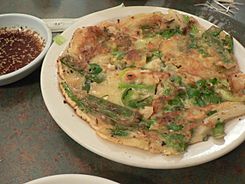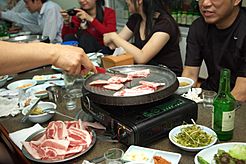Hoesik facts for kids
Hoesik (Korean: 회식, Hanja: 會食, transl. eating together) is a popular type of gathering in the society of South Korea, and refers to a group of people getting together to eat and drink. In Korean society, Hoesik has been established as a subculture of an organization or enterprise.
Contents
Origin
The origin of the Hoesik was based on the word "Hoe-min" of the Joseon Dynasty. It is said that the word "Hoe-min" was used in order to make the kings and officials of Joseon become 'Let's be one'. It seems that the most likely theory has changed from the word "Hoe-min" to "Hoesik". In this way, Hoesik is not a place for the individual, as it can be interpreted as an interpretation that the king and his subjects should live together and eat together.
Function
Positive function
Hoesik is a place where members of an organization can relax their tension and stress, increase their closeness to each other, and resolve conflicts. Enhance understanding among team members and help them become closer to each other. By reducing stress on members and eliminating inter-person and interdepartmental conflicts, it is possible to create harmony among members and increase efficiency of production.
Adverse effect
Forced attendance at hoesik
Many company employees are forced to attend, although their attendance is often passive and uncomfortable. Supervisors may lead the conversation while subordinates follow the conversation.
Loss of human relations with late hoesik
Most conversations at a hoesik may be with colleagues and supervisors and focus on company's shortcomings and company gossip. Negative talk and gossip can extend outside the hoesik, leading to a breakdown of relationships and the internal atmosphere.
Lack of intent
Most of them only have food and drink and refuse to express their inner feelings.
Foods
Rainy day
Koreans enjoy hoesik with Makgeolli (raw rice wine) and Jeon on a rainy day. There is a hypothesis that this is because the sound of the rain is similar to the sound of making the Jeon. And there is a hypothesis that on rainy days, your body's blood sugar level drops, helping to increase your blood sugar level. On rainy days, sales of flour and Makgeolli were also found to have risen sharply in large discount stores. A comparison of the rainy and sunny sales of Makgeolli and flour in Korean marts shows that sales of flour and MakgeollI rose 36.5 percent and 17.9 percent, respectively. This shows that Koreans eat a lot of Makgeolli and Jeon on rainy days.
Yellow dust day
Koreans eat a lot of samgyeopsal during "yellow dust" storms. It was a popular food among Korean miners, who ate it after work. This is because the miners have believed that after working in much dust, samgyeopsal washed the dust with their fat. And Koreans who enjoy Hoesik usually drinks soju with samgyeopsal. Because of its good taste and cheap price. For these reasons, eating with samgyeopsal and soju is popular on yellow dust days. However, there is no scientific evidence that samgyeopsal is good for yellow dust.



